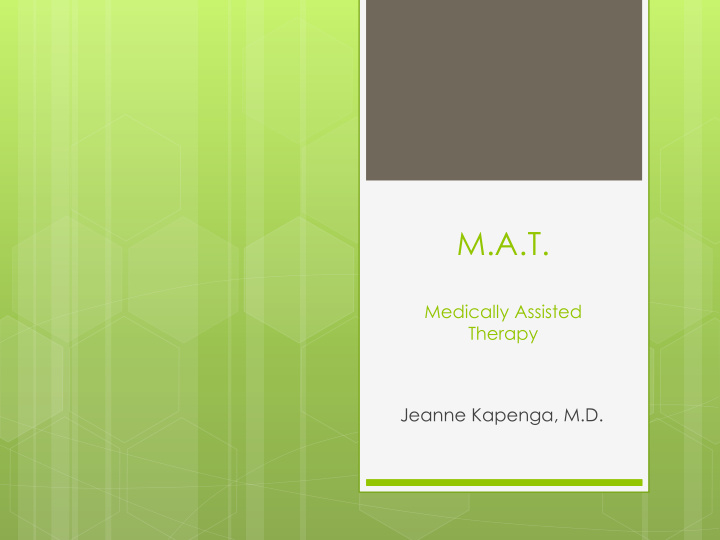



M.A.T. Medically Assisted Therapy Jeanne Kapenga, M.D.
Medically Assisted Therapy Recognized to aid in successful recovery programs along with counseling for 90% of patients Allows the natural neurochemistry to return to opioid/drug damaged brains by preventing cravings (and withdrawal) This process may take a year Some may never fully recover
Allows focus on counseling Cravings are distracting, and MAT provides medically proven improvement so pt’s can focus on their lifestyle changes The longer the period of abstinence, the sooner the brain’s neurochemistry normalizes and decision-making improves
THREE MAJOR GROUPS METHADONE: Gold standard - Opioid addiction BUPRENORPHINE: Suboxone, Subutex, etc - Opioid addiction NALTREXONE: Revia, Vivitrol (injection) - Opioid or alcohol addiction
METHADONE Federally regulated; distributed daily at a clinic Euphoria effect; legal heroin Long half-life means a long taper period Inexpensive
BUPRENORPHINE Several formulations: with or without naloxone (added for safety) Taken once or twice daily at home Federally regulated; X-waiver Diversion
NALTREXONE Not a controlled substance so not federally regulated No real diversion factor (no euphoria) Blocks cravings only For opioid or alcohol addiction
MAT does not work alone Is an adjunct to counseling, group therapy, step/community based groups and recovery coaching Benefits seen over time ie months to a year as the brain neurochemistry heals
MAT and the Family Allows them to remain at home, employed and functioning as a member of the family unit, if engaged in recovery Encourage family members to learn about the disease of addiction as the pt enters recovery, for best treatment outcome
COMMUNITY COLLABORATION This crisis is the “Worst man -made epidemic known to mankind” per CDC Scope and continuing escalation has been underestimated First time Judicial/Law Enforcement have made medical decisions for sentencing
SCOPE OF THE EPIDEMIC Prevention: Education in schools Disrupting the supply Surgery, dental, athletic entry Treatment: Engaging when ready Engaging when not ready “Meet them where THEY are at”
IT WILL TAKE A VILLAGE Schools Law enforcement Judicial system Medical providers Hospital/health care delivery systems Community based agencies Governmental at all levels
HEALTHCARE/HOSPITAL SYSTEM Multiple sectors of care involved Emergency room: Point of contact for overdose or other medical need - Assess for readiness for treatment Long term treatment options (months)
LAW ENFORCEMENT Now practicing medicine in the field with naloxone administration and transport to the E.D. if possible Even if they remain at home, option for tx
JUDICIAL SYSTEM Incarceration is NOT the solution, but treatment while incarcerated is Again, Judges are practicing medicine National trend for mandating treatment
STATISTICS Important in organizing our data collection here in MI: underreporting Evidence based decisions will depend upon accurate, timely statistics (daily) to recognize mass overdose situations Identifying demographic factors for determining policy in prevention Identifying locations of high use/resources
STATISTICS (continued) Evaluating resource efficacy – are the resources placed where they are needed? Are they effective? Standardized Medical Examiner reporting Developing evidence-based treatment programs in the community Don’t have time now to do formal 5 year studies – sense of urgency
Recommend
More recommend